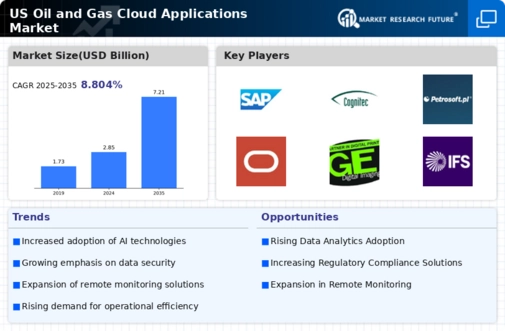Regulatory Compliance and Reporting
In the oil gas-cloud-applications market, regulatory compliance is a critical driver influencing cloud adoption. The industry is subject to stringent regulations regarding safety, environmental impact, and financial reporting. Cloud applications facilitate compliance by providing tools for data management, reporting, and audit trails. For instance, companies can leverage cloud solutions to automate compliance processes, reducing the risk of penalties associated with non-compliance. The market is witnessing an increase in the adoption of cloud technologies that support regulatory requirements, with estimates suggesting that compliance-related cloud solutions could grow by 25% in the coming years. This trend underscores the importance of regulatory compliance as a key driver in the oil gas-cloud-applications market, as firms strive to meet legal obligations while enhancing operational efficiency.
Advancements in IoT and Connectivity
The integration of Internet of Things (IoT) technologies is significantly impacting the oil gas-cloud-applications market. IoT devices enable real-time monitoring and data collection from various assets, enhancing operational visibility. This connectivity allows companies to analyze data more effectively, leading to improved decision-making and predictive maintenance. The market is projected to see a growth rate of 20% in IoT-enabled cloud applications over the next few years. As organizations seek to harness the power of IoT, the demand for cloud solutions that can process and analyze vast amounts of data is likely to increase. This trend indicates that advancements in IoT and connectivity are pivotal drivers in the oil gas-cloud-applications market, as they facilitate smarter operations and enhance overall efficiency.
Rising Demand for Operational Efficiency
The oil gas-cloud-applications market is experiencing a notable surge in demand for operational efficiency. Companies are increasingly adopting cloud-based solutions to streamline their operations, reduce costs, and enhance productivity. According to recent data, organizations that implement cloud applications can achieve operational cost reductions of up to 30%. This trend is driven by the need to optimize resource management and improve decision-making processes. As the industry faces fluctuating oil prices, the ability to operate efficiently becomes paramount. The integration of cloud technologies allows for real-time data access and analytics, enabling companies to respond swiftly to market changes. Consequently, the push for operational efficiency is a significant driver in the oil gas-cloud-applications market, as firms seek to maintain competitiveness in a challenging environment.
Increased Focus on Sustainability Initiatives
Sustainability is becoming a central theme in the oil gas-cloud-applications market, as companies strive to reduce their environmental footprint. The adoption of cloud applications supports sustainability initiatives by enabling better resource management and energy efficiency. For example, cloud-based solutions can optimize energy consumption in operations, potentially leading to reductions in greenhouse gas emissions. Recent studies indicate that organizations implementing sustainable practices can improve their market position and attract environmentally conscious investors. As the industry faces pressure to adopt greener practices, the focus on sustainability is likely to drive the growth of cloud applications in the oil gas sector. This trend highlights the importance of sustainability as a key driver in the oil gas-cloud-applications market, influencing strategic decisions and operational practices.
Enhanced Collaboration and Remote Work Capabilities
The oil gas-cloud-applications market is witnessing a shift towards enhanced collaboration and remote work capabilities. Cloud technologies facilitate seamless communication and collaboration among teams, regardless of their physical location. This is particularly relevant in an industry where field operations and office-based teams must work together efficiently. The ability to access data and applications from anywhere promotes flexibility and responsiveness. Recent data suggests that companies utilizing cloud solutions for collaboration can improve project delivery times by up to 40%. As remote work becomes more prevalent, the demand for cloud applications that support collaborative efforts is likely to grow. This trend indicates that enhanced collaboration and remote work capabilities are significant drivers in the oil gas-cloud-applications market, shaping the future of work in the industry.

















Leave a Comment